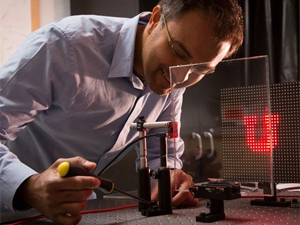



Date:28/08/18
 Scientists have created a new lensless camera that can capture photos using a standard pane of window glass.
Scientists have created a new lensless camera that can capture photos using a standard pane of window glass.
University of Utah electrical and computer engineers detailed their breakthrough in a new research paper titled “Computational Imaging Enables a ‘See-Through’ Lensless Camera,” which has been published in the latest issue of Optics Express.
The scientists say their goal was to develop a camera that creates photos optimized for machines to look at, rather than humans.
When an ordinary digital camera sensor is pointed at an object without a lens focusing light, the resulting photo looks like an undecipherable mess of colors. But that blob of pixel data actually still has enough information for computers to understand — you just need to train an AI system in “decoding” that blob to recover what the scene looked like.
Professor Rajesh Menon and his team displayed patterns on an LED light board and placed a plexiglass window in front of it. An off-the-shelf camera sensor was then placed at the side of the plexiglass (which has reflective tape wrapped around it), “staring” straight into the edge of the pane at a 90-degree angle.
While most of light from the LED panel passes right through the glass, roughly 1% of it scatters through the window and into the sensor. That’s enough data for the computer to decode.
The sensor was able to blurry CMOS images that could then be turned into low-resolution photos of the LED pattern. In addition to color photos, the camera can also capture full-motion video.
In the future, using more powerful sensors may be able to produce higher-resolution photos.
“Applications for a lensless camera can be almost unlimited,” the University of Utah writes. “Security cameras could be built into a home during construction by using the windows as lenses.”
Menon and his team are currently working on improving the system to shoot higher-resolution photos of objects using standard household lighting.
Scientists Develop a Lensless Camera That Uses a Glass Window Instead
 Scientists have created a new lensless camera that can capture photos using a standard pane of window glass.
Scientists have created a new lensless camera that can capture photos using a standard pane of window glass.University of Utah electrical and computer engineers detailed their breakthrough in a new research paper titled “Computational Imaging Enables a ‘See-Through’ Lensless Camera,” which has been published in the latest issue of Optics Express.
The scientists say their goal was to develop a camera that creates photos optimized for machines to look at, rather than humans.
When an ordinary digital camera sensor is pointed at an object without a lens focusing light, the resulting photo looks like an undecipherable mess of colors. But that blob of pixel data actually still has enough information for computers to understand — you just need to train an AI system in “decoding” that blob to recover what the scene looked like.
Professor Rajesh Menon and his team displayed patterns on an LED light board and placed a plexiglass window in front of it. An off-the-shelf camera sensor was then placed at the side of the plexiglass (which has reflective tape wrapped around it), “staring” straight into the edge of the pane at a 90-degree angle.
While most of light from the LED panel passes right through the glass, roughly 1% of it scatters through the window and into the sensor. That’s enough data for the computer to decode.
The sensor was able to blurry CMOS images that could then be turned into low-resolution photos of the LED pattern. In addition to color photos, the camera can also capture full-motion video.
In the future, using more powerful sensors may be able to produce higher-resolution photos.
“Applications for a lensless camera can be almost unlimited,” the University of Utah writes. “Security cameras could be built into a home during construction by using the windows as lenses.”
Menon and his team are currently working on improving the system to shoot higher-resolution photos of objects using standard household lighting.
Views: 454
©ictnews.az. All rights reserved.Similar news
- The mobile sector continues its lead
- Facebook counted 600 million active users
- Cell phone testing laboratory is planned to be built in Azerbaijan
- Tablets and riders outfitted quickly with 3G/4G modems
- The number of digital TV channels will double to 24 units
- Tax proposal in China gets massive online feedback
- Malaysia to implement biometric system at all entry points
- Korea to build Green Technology Centre
- Cisco Poised to Help China Keep an Eye on Its Citizens
- 3G speed in Azerbaijan is higher than in UK
- Government of Canada Announces Investment in Green Innovation for Canada
- Electric cars in Azerbaijan
- Dominican Republic Govt Issues Cashless Benefits
- Spain raises €1.65bn from spectrum auction
- Camden Council boosts mobile security





















